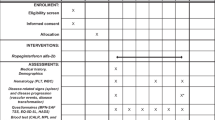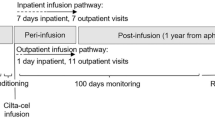Abstract
Background
Trough- or 2-h post-dose (C2) blood cyclosporine (CsA) concentrations are used for prediction of efficacy and toxicity of CsA in transplant recipients concomitantly treated with antiproliferative agents, but information on utility of blood CsA levels in patients treated with proliferation signal inhibitors (PSIs), such as everolimus, is sparse. Because of the inhibitory effect of PSIs on the P-glycoprotein drug efflux pump present in lymphocytes, we hypothesized that CsA pharmacokinetics in blood and lymphocytes were dissociated in patients concomitantly treated with everolimus.
Methods
Twelve-hour pharmacokinetic studies of whole-blood and intralymphocytic CsA concentrations were conducted in long-term heart-transplant recipients treated with mycophenolate mofetil (MMF) + CsA (n = 8) and everolimus + CsA (n = 9).
Results
There was a highly significant correlation between blood CsA C2 levels and blood CsA AUC0–12 in groups of patients treated with MMF or everolimus (R 2 0.93 and 0.96, respectively; P < 0.001 for both). Whereas blood CsA C2 levels were closely associated with lymphocyte CsA AUC0–12 in patients treated with MMF (R 2 = 0.98), there was poor correlation between whole-blood C2 and lymphocyte AUC0–12 in patients treated with everolimus (R 2 = 0.24).
Conclusion
Standard blood CsA levels accurately predict intralymphocytic exposure to CsA in patients concomitantly treated with MMF but not in patients treated with everolimus.


Similar content being viewed by others
References
Taylor DO, Edwards LB, Boucek MM, Trulock EP, Aurora P, Christie J, Dobbels F, Rahmel AO, Keck BM, Hertz MI (2007) Registry of the International Society for Heart and Lung Transplantation: twenty-fourth official adult heart transplant report–2007. J Heart Lung Transplant 26:769–781
Alam A, Badovinac K, Ivis F, Trpeski L, Cantarovich M (2007) The outcome of heart transplant recipients following the development of end-stage renal disease: analysis of the Canadian Organ Replacement Register (CORR). Am J Transplant 7:461–465
Angermann CE, Stork S, Costard-Jackle A, Dengler TJ, Siebert U, Tenderich G, Rahmel A, Schwarz ER, Nagele H, Wagner FM, Haaff B, Pethig K (2004) Reduction of cyclosporine after introduction of mycophenolate mofetil improves chronic renal dysfunction in heart transplant recipients–the IMPROVED multi-centre study. Eur Heart J 25:1626–1634
Grant D, Kneteman N, Tchervenkov J, Roy A, Murphy G, Tan A, Hendricks L, Guilbault N, Levy G (1999) Peak cyclosporine levels (Cmax) correlate with freedom from liver graft rejection: results of a prospective, randomized comparison of Neoral and Sandimmune for liver transplantation (NOF-8). Transplantation 67:1133–1137
Cantarovich M, Besner JG, Barkun JS, Elstein E, Loertscher R (1998) Two-hour cyclosporine level determination is the appropriate tool to monitor Neoral therapy. Clin Transplant 12:243–249
Delgado DH, Rao V, Hamel J, Miriuka S, Cusimano RJ, Ross HJ (2005) Monitoring of cyclosporine 2-hour post-dose levels in heart transplantation: improvement in clinical outcomes. J Heart Lung Transplant 24:1343–1346
Cantarovich M, Elstein E, de Varennes B, Barkun JS (1999) Clinical benefit of Neoral dose monitoring with cyclosporine 2-hr post-dose levels compared with trough levels in stable heart transplant patients. Transplantation 68:1839–1842
Cantarovich M, Ross H, Arizon JM, Gomez MA, Straatman L, Orus J, Alonso-Pulpon L, Molina BD, Wang S, Lage E, Crespo MG, Manito N, Howlett J, Haddad H (2008) Benefit of Neoral C2 monitoring in de novo cardiac transplant recipients receiving basiliximab induction. Transplantation 85:992–999
Eisen HJ, Tuzcu EM, Dorent R, Kobashigawa J, Mancini D, Valantine-von Kaeppler HA, Starling RC, Sorensen K, Hummel M, Lind JM, Abeywickrama KH, Bernhardt P (2003) Everolimus for the prevention of allograft rejection and vasculopathy in cardiac-transplant recipients. N Engl J Med 349:847–858
Gustafsson F, Ross HJ, Delgado MS, Bernabeo G, Delgado DH (2007) Sirolimus-based immunosuppression after cardiac transplantation: predictors of recovery from calcineurin inhibitor-induced renal dysfunction. J Heart Lung Transplant 26:998–1003
Ross H, Pflugfelder P, Haddad H, Cantarovich M, White M, Ignaszewski A, Howlett J, Vaillancourt M, Dorent R, Burton JR (2008) Cyclosporine reduction in the presence of everolimus: 3-month data from a Canadian pilot study of maintenance cardiac allograft recipients. J Heart Lung Transplant 27:197–202
Kahan BD, Wong RL, Carter C, Katz SH, Von Fellenberg J, Van Buren CT, Appel-Dingemanse S (1999) A phase I study of a 4-week course of SDZ-RAD (RAD) quiescent cyclosporine-prednisone-treated renal transplant recipients. Transplantation 68:1100–1106
Podder H, Stepkowski SM, Napoli KL, Clark J, Verani RR, Chou TC, Kahan BD (2001) Pharmacokinetic interactions augment toxicities of sirolimus/cyclosporine combinations. J Am Soc Nephrol 12:1059–1071
Anglicheau D, Pallet N, Rabant M, Marquet P, Cassinat B, Meria P, Beaune P, Legendre C, Thervet E (2006) Role of P-glycoprotein in cyclosporine cytotoxicity in the cyclosporine-sirolimus interaction. Kidney Int 70:1019–1025
Hotchkiss RS, Osmon SB, Chang KC, Wagner TH, Coopersmith CM, Karl IE (2005) Accelerated lymphocyte death in sepsis occurs by both the death receptor and mitochondrial pathways. J Immunol 174:5110–5118
Barbari AG, Masri MA, Stephan AG, El Ghoul B, Rizk S, Mourad N, Kamel GS, Kilani HE, Karam AS (2006) Cyclosporine lymphocyte maximum level monitoring in de novo kidney transplant patients: a prospective study. Exp Clin Transplant 4:400–405
Falck P, Asberg A, Guldseth H, Bremer S, Akhlaghi F, Reubsaet JL, Pfeffer P, Hartmann A, Midtvedt K (2008) Declining intracellular T-lymphocyte concentration of cyclosporine a precedes acute rejection in kidney transplant recipients. Transplantation 85:179–184
Mardigyan V, Giannetti N, Cecere R, Besner JG, Cantarovich M (2005) Best single time points to predict the area-under-the-curve in long-term heart transplant patients taking mycophenolate mofetil in combination with cyclosporine or tacrolimus. J Heart Lung Transplant 24:1614–1618
Farrell RJ, Menconi MJ, Keates AC, Kelly CP (2002) P-glycoprotein-170 inhibition significantly reduces cortisol and ciclosporin efflux from human intestinal epithelial cells and T lymphocytes. Aliment Pharmacol Ther 16:1021–1031
Laplante A, Demeule M, Murphy GF, Beliveau R (2002) Interaction of immunosuppressive agents rapamycin and its analogue SDZ-RAD with endothelial P-gp. Transplant Proc 34:3393–3395
Serkova N, Hausen B, Berry GJ, Jacobsen W, Benet LZ, Morris RE, Christians U (2000) Tissue distribution and clinical monitoring of the novel macrolide immunosuppressant SDZ-RAD and its metabolites in monkey lung transplant recipients: interaction with cyclosporine. J Pharmacol Exp Ther 294:323–332
Rodrigues AC, Curi R, Britto LR, Rebbechi IM, Hirata MH, Bertolami MC, Bernik MM, Dorea EL, Hirata RD (2006) Down-regulation of ABCB1 transporter by atorvastatin in a human hepatoma cell line and in human peripheral blood mononuclear cells. Biochim Biophys Acta 1760:1866–1873
Crettol S, Venetz JP, Fontana M, Aubert JD, Ansermot N, Fathi M, Pascual M, Eap CB (2008) Influence of ABCB1 genetic polymorphisms on cyclosporine intracellular concentration in transplant recipients. Pharmacogenet Genomics 18:307–315
Donnenberg VS, Burckart GJ, Zeevi A, Griffith BP, Iacono A, McCurry KR, Wilson JW, Donnenberg AD (2004) P-glycoprotein activity is decreased in CD4+ but not CD8+ lung allograft-infiltrating T cells during acute cellular rejection. Transplantation 77:1699–1706
Acknowledgements
The authors wish to acknowledge Dr. P.Y. Wong, Toronto General Hospital, for his expert advice on cyclosporine measurements.
Author information
Authors and Affiliations
Corresponding author
Rights and permissions
About this article
Cite this article
Gustafsson, F., Barth, D., Delgado, D.H. et al. The impact of everolimus versus mycophenolate on blood and lymphocyte cyclosporine exposure in heart-transplant recipients. Eur J Clin Pharmacol 65, 659–665 (2009). https://doi.org/10.1007/s00228-009-0663-2
Received:
Accepted:
Published:
Issue Date:
DOI: https://doi.org/10.1007/s00228-009-0663-2




